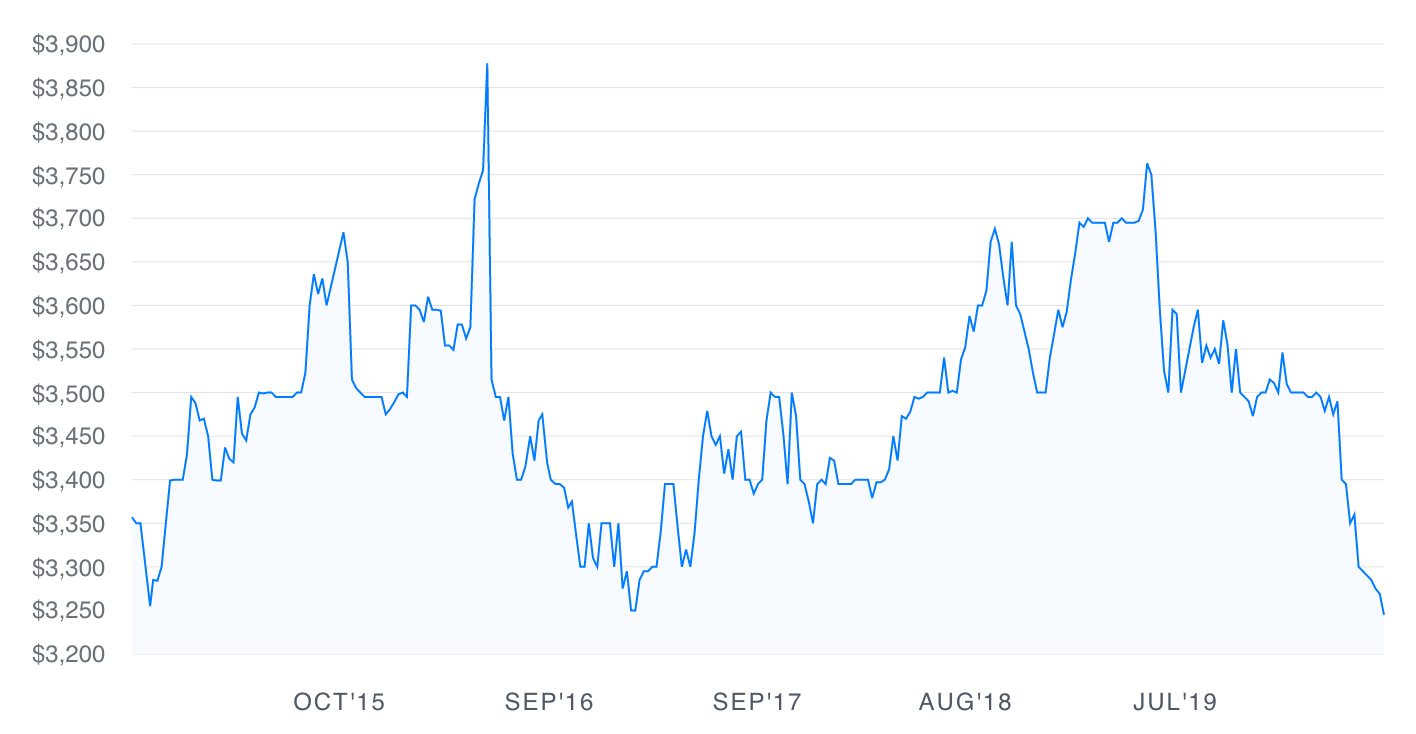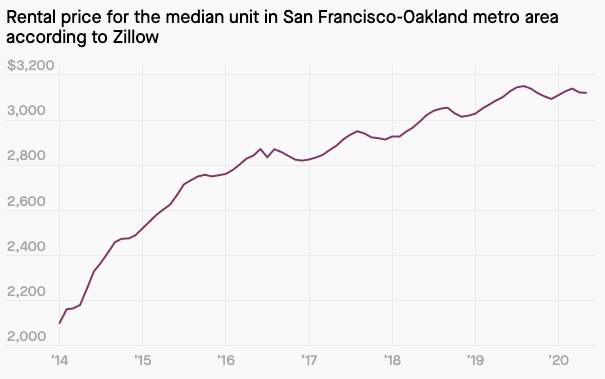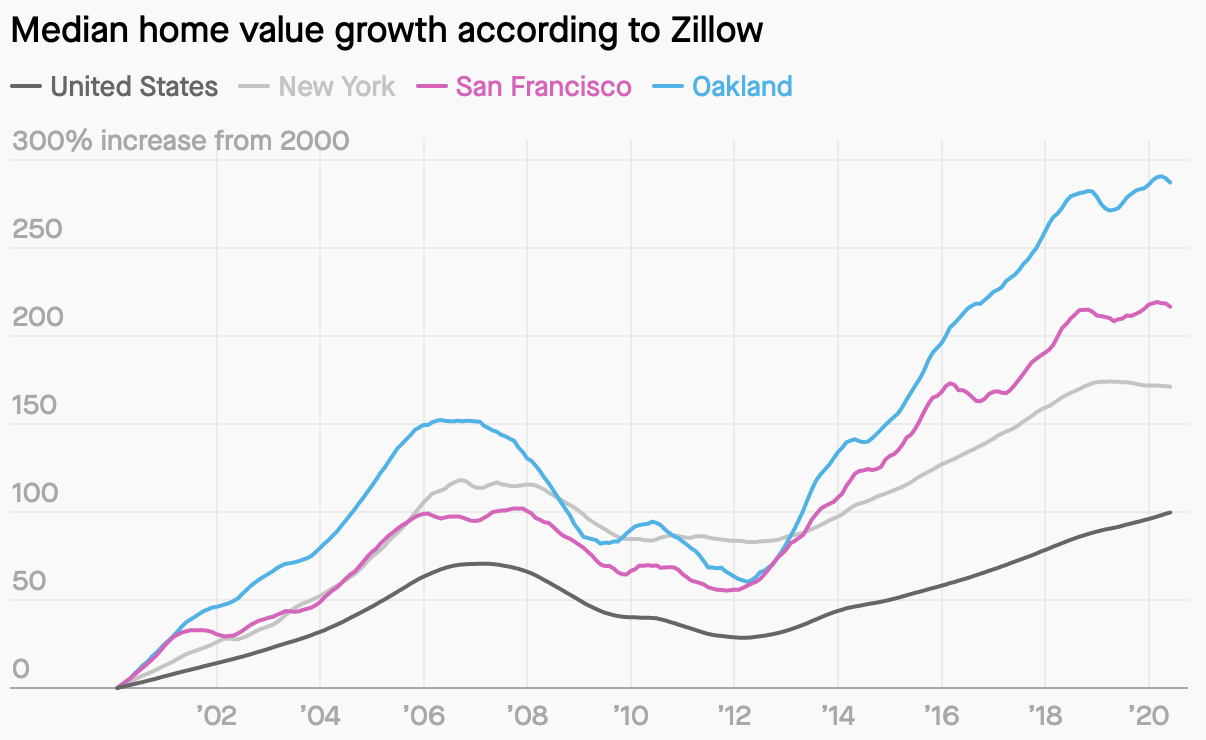Thanks for joining me for the 18th issue of the Golden Stats Warrior, a newsletter for data-based insights about the Bay Area. If this is your first time reading, welcome! If you haven’t signed up yet, you can do that here. I am so grateful for your support.
On July 1, the apartment rental site Zumper released their monthly report on the state of local rental market. The numbers they reported for the Bay Area were staggering.
According to their data, the rental price of a one bedroom in San Francisco had fallen nearly 12% from a year ago. Two bedrooms were down nearly 10%. At the same time, prices had actually risen by over 4% for a one or two bedroom in Oakland.
Zumper’s CEO used this data to claim that the economic impacts of the pandemic and the move of many Silicon Valley firms to remote work were leading people to leave San Francisco and head to cheaper and more spacious places like Oakland (admittedly only a bit cheaper) and Sacramento. The data was reported by a number of local news outlets and the Wall Street Journal.
So is it true? Are San Francisco rents plummeting, while Oakland rents soar? Count me as skeptical.
I don’t doubt that Covid-19 is changing the Bay Area housing market, but if you are trying to get a sense of trends in the rental prices, Zumper’s data is not a good place to start.
The rental number Zumper reports is very simple. Essentially, it is the median price for available one-bedrooms for which they have found a listing. So that means if a very expensive apartment building opens up in Oakland that is full of one-bedrooms, their median rent number will rise. Or if a very cheap apartment opens up, the number will decline. But the new expensive apartment buildings didn’t actually make it more expensive for the average person to live in Oakland. It just meant there was more inventory. (Read their methodology here.)
In other words, they don’t actually track what most people care about: whether the price of a one-bedroom of the same quality in the same location is changing. They are tracking shifts in the mix of what’s available, which may or may not reflect anything about that one-bedroom’s price.
Zumper’s July 1st report on rental prices (Not Golden Stats Warrior approved)

Here are a few data points complicating Zumper’s story about the pandemic and rental markets.
Do you remember the great San Francisco rent price drop of the summer of 2019? I certainly don’t. But according to Zumper’s data, the median one bedroom in San Francisco fell from $3,763 on June 8th to $3,525 on July 6th, less than a month later. That’s an amazing 7% drop!
Was there really such a big decline in rental prices? No. The data is just noisy. Check out the chart from their website below.
Median rent for a one-bedroom in San Francisco, according to Zumper (Not Golden Stats Warrior approved)

So what about the idea that Oakland prices are rising as people flock to the East Bay from San Francisco? Zumper’s own data actually contradicts that idea.
Oakland rents for a one-bedroom actually went down from about $2,500 in January 2020 to $2,250 in July 2020, a 10% drop, according to their data. Most of the “growth” they mention actually happened at the end of 2019. This doesn’t fit Zumper’s narrative that pandemic is raising Oakland prices.
Median rent for a one-bedroom in Oakland, according to Zumper (Not Golden Stats Warrior approved)

Data from real estate giant Zillow also does not at support Zumper’s finding of a large drop off.
Zillow uses a more sophisticated methodology than Zumper’s that does actually try to estimate how much an apartment of the same quality rented for over time. They do this by “calculating price differences for the same rental unit over time, then aggregating those differences across all properties repeatedly listed for rent on Zillow.” It’s not perfect, but it’s a lot better.
Zillow’s data does suggest that rental prices are growing much slower than they have over the past several years, but it does not find any substantial decrease. They also find that the growth in rental prices in Sacramento are slowing as well, which again, does not fit Zumper’s story.

For more details on the issues with Zumper’s data, check out the economist Joe Cortright’s discussion of their methods in his brilliantly titled article “‘Caveat Rentor’—Beware of Crazy Rent Statistics.” As Cortright mentions, these data problems don’t suggest any issue with Zumper’s actual business. It just suggests they shouldn’t be releasing economic statistics.
All that said, I think it’s certainly plausible that Bay Area rents could fall. The Bay Area economy has been hit hard, particularly for low-income workers, and many people may decide to leave the area because they can’t make rent. There is evidence that large numbers of young adults are moving back in with family during the pandemic, which may decrease demand for units. Tech firms are increasingly saying remote work will be allowed long term, which would permit people who would rather live outside the Bay Area to move, further decreasing demand. We just don’t have a lot of evidence yet that any of this has made a meaningful dent in Bay Area rents.
What we do know is that rents have skyrocketed in the Bay Area over the last several decades due to a lack of new housing, particularly in richer suburban parts of the region. Since the start of 2014, rents have gone up in San Francisco-Oakland area by 48%, compared to 27% in the average US city, according to Zillow’s data. Housing prices, which are strongly correlated with rental data, have risen far faster in San Francisco and Oakland since 2000 than in the rest of the US and other expensive cities like New York.

It’s important to remember that the pandemic is not going solve the Bay Area’s housing issues. This will continue to be an exorbitantly expensive place for people to live, particularly for those without white collar jobs, until we build massive amounts of new housing—both subsidized and market. Suggesting that Covid-19 is going to make the Bay Area much more affordable is a distraction.
Since I was looking at this housing data I decided to make a table of the neighborhoods that have seen the highest growth in housing prices since 2000, according to Zillow’s neighborhood data. Click on this link to explore every neighborhood in the San Francisco-Oakland metropolitan area for which they had data.
Crocker Highlands, Oakland, where prices have risen more than 800%, was the 10th fastest rising neighborhood in the US (Zillow had data for over 12,000 neighborhoods nationwide). If you explore the link you will find that Oakland and Alameda neighborhoods saw the greatest growth, with San Francisco neighborhoods, which were already quite expensive, further down the list.

Bay Area media recommendations of the week
Mission Local reporter Julian Mark has been doing terrific work documenting San Francisco’s efforts to reform the city’s police. He has written about attempts to revise SFPD’s use-of-force policy, which include explicitly banning officers from using their knees to restrain people in the way that killed George Floyd, and the police union’s attempts to slow down the reform. His work also covers BART’s move to decrease funding to its police department, and BART Director John McPartland’s comments at a budget meeting defending the character of confederate general Robert E. Lee. It is truly the best kind of reporting, informing the public and holding those in power to account.
(If you read or listened to something great about the Bay Area this week, please send it to me!)
Dan’s favorite things
Grove Way Bonsai Nursery in Fremont feels more like a botanical garden or museum than it does a store. In the backyard of the unassuming shop are some of the most beautiful plants I have seen in my life. When I visited recently, the 85-year-old bonsai teacher Johnny Uchida guided us through the process of choosing a good tree for a novice, and explained that we needed to water the plant every day without fail. He also showed us a gorgeous 135-year-old tree that he had been watering every day for 40 years. If for some reason you need to be away from your plant for more than a couple days, Grove Way will “babysit” your plants.
Thanks for your time, and see you in a couple weeks.
If you think a friend might enjoy this newsletter, please forward it along. You can follow me on Twitter at @dkopf or email me at dan.kopf@gmail.com
The Golden Stats Warrior logo was made by the great Jared Joiner, the best friend a nervous newsletter writer could have. Follow him @jnjoiner. Also, thanks to the generous Michael Chasnow for copy editing this week.


